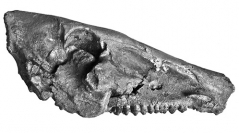

 Geodiversitas
38 (1) - Pages 99-134
Geodiversitas
38 (1) - Pages 99-134Early Pliocene suids of Europe are generally rare and poorly preserved, but some exceptional fossils have been found at Roussillon, France, Villafranca d’Asti, Italy, and Kvabebi, Georgia. We here describe and interpret an almost complete skull of a small suid from Musaitu and a mandible fragment from Dermenji, Moldova, which add precious information to the data base concerning these small European Pliocene suids, here attributed to Dasychoerus arvernensis (Croizet & Jobert, 1828). The Moldovan fossils provide an important biogeographic link between the Western European and Asian Plio-Pleistocene suines. The Musaitu skull, in particular, shows the elongated snout, enlarged canine flanges, pneumatised zygomatic arch and low slung incisor row characteristic of the genus Dasychoerus Gray, 1873. This species is important because it represents the group from which the African Kolpochoerus Van Hoepen & Van Hoepen, 1932 lineage probably emerged. The latter group is useful for biochronology because, having arrived in Africa, where it has been called Kolpochoerus deheinzelini Brunet & White, 2001 (in fact a junior synonym of Dasychoerus arvernensis) it evolved rapidly in dimensions and dental morphology. During the Pliocene the genus Dasychoerus, already adapted to tropical and sub-tropical climates, was widespread in mid-latitude Eurasia and Africa, but when much of mid-latitude Eurasia became boreal during the Plio-Pleistocene, the range of Dasychoerus shrank equatorwards, giving way to boreally adapted Sus scrofa Linnaeus, 1758 over much of its former territory, leaving a disjunct distribution of its descendants in Africa (Hylochoerus Thomas, 1904, possibly Potamochoerus Gray, 1854) and the tropical islands of the Far East (Dasychoerus).
Moldova, Pliocene, Suidae, Dasychoerus, Kolpochoerus, Evolution, Palaeobiogeography